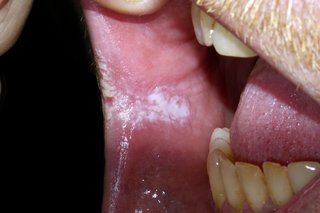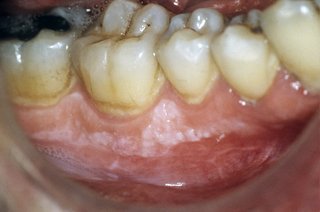Leukoplakia is a white patch in the mouth. A white patch in your mouth that does not go away should be checked by a dentist or GP.
Check if you have leukoplakia

/ Alamy Stock Photo

SCIENCE PHOTO LIBRARY

CNRI/SCIENCE PHOTO LIBRARY
It's also possible to get patches on the floor or roof of your mouth.
The patches:
- are not painful
- are an irregular shape
- are slightly raised
- may be slightly red within the patch
- cannot be rubbed or scraped away (patches that can be removed could be oral thrush)
There are also a number of other causes of white patches on the tongue.
Non-urgent advice: See a dentist or GP if you have:
- a white patch in your mouth that has not gone away after 2 weeks
- a white patch on your tongue and a weakened immune system – for example, you have HIV or have had an organ transplant
Mouth cancer risk
If you have leukoplakia, there's a small risk it could progress to mouth cancer over time.
This is why it's very important to see your dentist or GP if you have a white patch in your mouth.
What happens at your appointment
Your dentist or GP will examine the patch and be able to rule out other possible causes like a fungal infection of the mouth (oral thrush) or cheek biting.
You may be referred to a specialist for a biopsy. A small piece of tissue from the patch will be removed and checked for abnormal cells.
Treatments for leukoplakia
Treatment for leukoplakia is not always needed, but you'll have regular check-ups to make sure the patch is not getting bigger.
The patch may get smaller or go away if you:
- stop smoking
- reduce the amount of alcohol you drink
An operation is sometimes needed to remove the patch if there's a risk it could become cancerous.
This may be done while the area is numbed (local anaesthetic) or while you're asleep (general anaesthetic).
The patch can be removed in a number of ways, including using a laser or a surgical scalpel. Your mouth should heal quickly afterwards.
Preventing leukoplakia and mouth cancer
In the UK, leukoplakia is mostly caused by smoking. But sometimes the exact cause is not known.
There are things you can do to reduce your risk of getting leukoplakia. These may also reduce your chances of getting mouth cancer.
Do
-
keep your mouth and teeth healthy by taking care of your teeth and gums
-
have regular dental check-ups
-
if you wear dentures, make sure they fit properly
-
eat a balanced diet, including plenty of fresh fruit and vegetables
Don't
-
do not smoke
-
do not drink more than the recommended amount of alcohol
Hairy leukoplakia
Hairy leukoplakia is a type of leukoplakia caused by the Epstein-Barr virus.
It often affects people with a weakened immune system, particularly those with HIV and AIDS or who have had an organ transplant and are taking immunosuppressant medication.
It causes fuzzy white patches, often on the sides of the tongue, that look folded or ridged. They are not painful and cannot be brushed or scraped away.
Antiviral medications, or treatments applied directly to the patch, may be prescribed to treat hairy leukoplakia.
Unlike other types of leukoplakia, hairy leukoplakia does not carry a risk of mouth cancer.
Page last reviewed: 5 January 2018
Next review due: 5 January 2021
